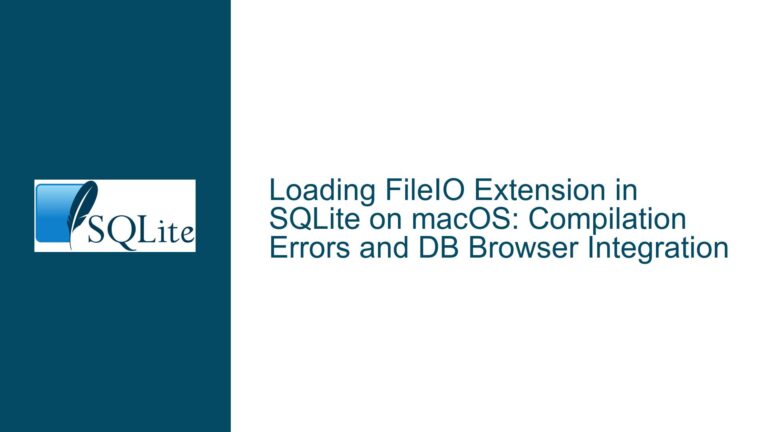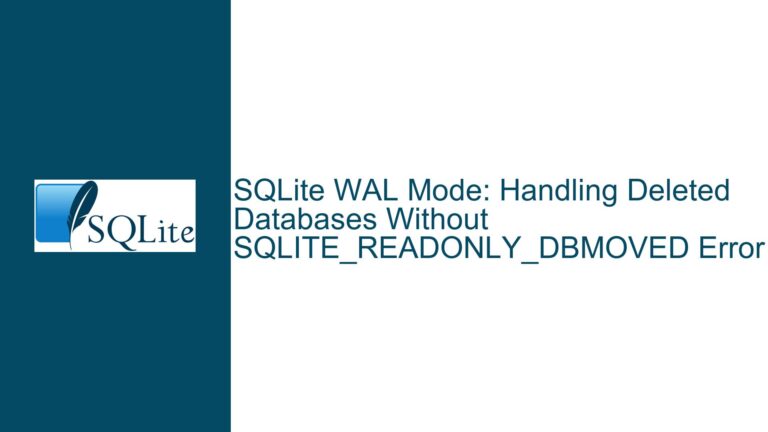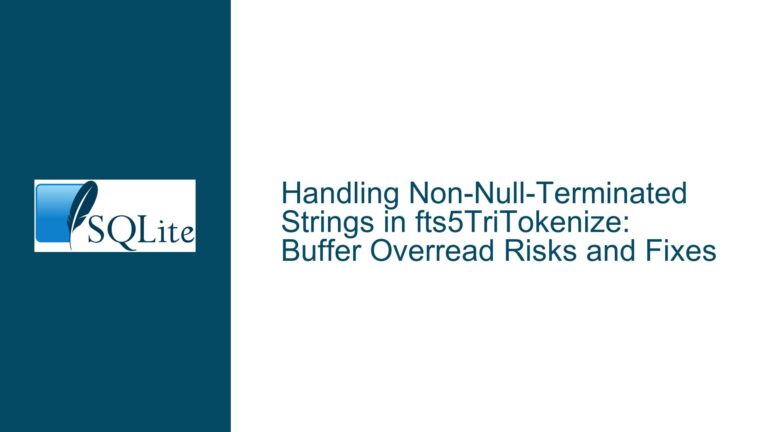Resolving PyQt6 SQLite Database Connection Crashes on Windows
Understanding PyQt6 QSQLITE Driver Initialization Requirements
The core issue revolves around a process crash occurring during attempts to open an SQLite database connection using PyQt6’s QSqlDatabase module on Windows systems. The fatal error manifests as exit code -1073741819 (0xC0000005), indicating a memory access violation typically caused by improper initialization of Qt framework components before interacting with database subsystems. This crash specifically occurs when developers attempt to use QSqlDatabase.open() without first establishing the required Qt application context.
Fundamental Architecture Relationships
PyQt6’s database handling relies on Qt’s C++ framework architecture where:
- QCoreApplication/QApplication manages the event loop and resource initialization
- QSqlDatabase acts as the database connection manager
- QSQLITE driver serves as the bridge to SQLite functionality
The crash occurs because database operations require Qt’s internal infrastructure (memory management, driver registration, error handling subsystems) that only becomes available after creating a Q(Core)Application instance. Without this foundational layer, attempts to access database resources trigger undefined behavior manifested as memory access violations.
Critical Missing Qt Application Context Initialization
The primary cause stems from attempting database operations before initializing Qt’s application context. PyQt6 requires explicit creation of either:
- QCoreApplication for console/non-GUI applications
- QApplication for GUI applications
This initialization sequence establishes:
- Qt’s internal memory management systems
- Driver registration mechanisms
- Event processing pipelines
- Resource cleanup handlers
When omitted, the QSQLITE driver attempts to access uninitialized memory structures, leading to access violations. The Windows environment particularly enforces strict memory protection policies that immediately terminate processes violating these rules, unlike some UNIX-like systems that might exhibit different failure modes.
Secondary Contributing Factors
- Incorrect Application Type Selection: Using QCoreApplication in GUI-enhanced database applications causes incomplete initialization of GUI-related database components
- Improper Lifetime Management: Premature destruction of application objects before database operations complete
- Thread Safety Violations: Attempting database access from threads without proper Q(Core)Application context
- Path Resolution Errors: Incorrect database file paths causing silent initialization failures that compound with missing application context
- Binary Compatibility Issues: Mismatched Qt/PyQt6/SQLite library versions creating subtle initialization requirements
Comprehensive Initialization Protocol for Database Access
Step 1: Foundation Layer Initialization
GUI Applications
from PyQt6.QtWidgets import QApplication
import sys
# Must create before any Qt objects
app = QApplication(sys.argv)
Console Applications
from PyQt6.QtCore import QCoreApplication
app = QCoreApplication([]) # Empty argument list
Critical Implementation Details
- Create application instance before any QSqlDatabase operations
- Maintain application reference throughout database lifecycle
- For script execution, prevent immediate exit with
sys.exit(app.exec())
Step 2: Database Configuration Sequence
Proper Driver Initialization
from PyQt6.QtSql import QSqlDatabase
# Explicit driver specification
db = QSqlDatabase.addDatabase("QSQLITE")
# Alternative direct instance creation
db = QSqlDatabase.database("QSQLITE", open=False)
db = QSqlDatabase("QSQLITE")
Path Validation Techniques
from pathlib import Path
db_path = Path(__file__).parent / "chinook.sqlite"
if not db_path.exists():
raise FileNotFoundError(f"Database missing: {db_path}")
db.setDatabaseName(str(db_path.absolute()))
Step 3: Connection Management Best Practices
Robust Open/Close Handling
try:
if db.open():
print(f"Connected to {db.databaseName()}")
# Database operations here
else:
last_error = db.lastError()
print(f"Connection failed: {last_error.text()}")
finally:
db.close()
app.quit() # Clean application exit
Advanced Configuration Options
# Set connection parameters
db.setConnectOptions("QSQLITE_OPEN_READONLY;QSQLITE_ENABLE_REGEXP")
# Verify driver capabilities
if not db.isValid():
print("QSQLITE driver unavailable")
Step 4: Application Event Loop Integration
Persistent Execution Context
if __name__ == "__main__":
import sys
app = QApplication(sys.argv)
# Database operations here
sys.exit(app.exec()) # Maintain open context
Console Application Pattern
app = QCoreApplication([])
# Perform database tasks
app.exec() # Start event loop
Step 5: Diagnostic Procedures
Memory Initialization Checks
from PyQt6.QtCore import qDebug
if QSqlDatabase.isDriverAvailable("QSQLITE"):
qDebug("QSQLITE driver registered")
else:
qDebug("Driver missing - check Qt plugins")
Crash Analysis Techniques
- Use Windows Event Viewer to examine application fault module
- Run with
python -X faulthandlerto pinpoint crash locations - Debug with Visual Studio’s debugger to capture stack traces
Step 6: Cross-Platform Considerations
Linux/macOS Differences
- May display segmentation fault instead of access violation
- Environment variables affect plugin paths:
os.environ["QT_DEBUG_PLUGINS"] = "1"
File Permission Handling
# Windows-specific lock checking
if os.name == 'nt':
from ctypes import windll
handle = windll.verifier.GetApplicationRestartSettings()
Step 7: Alternative Initialization Patterns
Delayed Initialization Approach
app = None
def init_db():
global app
app = QCoreApplication([])
# Database setup
Multiple Database Contexts
app = QApplication(sys.argv)
primary_db = QSqlDatabase.addDatabase("QSQLITE", "MAIN")
secondary_db = QSqlDatabase.addDatabase("QSQLITE", "LOG")
Step 8: Troubleshooting Matrix
| Symptom | Diagnostic Action | Potential Fix |
|---|---|---|
| Immediate exit code | Check application.exec() presence | Add event loop execution |
| Missing driver errors | Verify Qt plugin paths | Set QT_PLUGIN_PATH environment variable |
| Partial functionality | Validate QApplication vs QCoreApp | Use QApplication for GUI features |
| Intermittent crashes | Inspect object lifetime management | Maintain app reference in global scope |
Step 9: Advanced Configuration Scenarios
Custom SQLite Driver Configuration
from PyQt6.QtSql import QSqlDriver
driver = db.driver()
driver.beginTransaction()
# Custom transaction handling
Plugin Path Overrides
import os
from pathlib import Path
qt_plugin_path = Path(QtCore.__file__).parent / "Qt6" / "plugins"
os.environ["QT_PLUGIN_PATH"] = str(qt_plugin_path)
SQLite Extended Features
# Enable foreign key constraints
db.exec("PRAGMA foreign_keys = ON;")
# Set journaling mode
db.exec("PRAGMA journal_mode = WAL;")
Step 10: Permanent Solution Implementation
Template for Reliable Database Access
import sys
import os
from PyQt6.QtWidgets import QApplication
from PyQt6.QtSql import QSqlDatabase
class DatabaseManager:
def __init__(self):
self.app = QApplication(sys.argv)
self._init_db()
def _init_db(self):
self.db = QSqlDatabase.addDatabase("QSQLITE")
path = os.path.join(os.path.dirname(__file__), "chinook.sqlite")
if not os.access(path, os.R_OK):
raise PermissionError(f"Access denied: {path}")
self.db.setDatabaseName(path)
if not self.db.open():
err = self.db.lastError()
raise ConnectionError(err.text())
def __del__(self):
self.db.close()
self.app.quit()
if __name__ == "__main__":
try:
db_mgr = DatabaseManager()
# Application logic here
sys.exit(db_mgr.app.exec())
except Exception as e:
print(f"Critical failure: {str(e)}")
sys.exit(1)
This comprehensive approach ensures proper initialization order, maintains required object references, and implements defensive programming practices. The solution handles cross-platform considerations, implements proper cleanup procedures, and provides diagnostic capabilities through structured error handling.
Final Implementation Checklist
Application Context
- Instantiate QApplication/QCoreApplication first
- Maintain instance throughout database operations
Path Validation
- Verify absolute file paths
- Check read/write permissions
Error Handling
- Inspect QSqlError after failed operations
- Use try/except blocks around open()
Resource Management
- Explicitly close database connections
- Properly quit application instance
Diagnostic Instrumentation
- Enable Qt debug plugins
- Capture lastError() details
By methodically addressing the initialization sequence, maintaining proper object lifetimes, and implementing robust error handling, developers can eliminate the 0xC0000005 crash while establishing reliable SQLite database connectivity through PyQt6’s QSQLITE driver. The solution scales from simple scripts to complex applications by adhering to Qt’s architectural requirements and leveraging Python’s exception handling capabilities.






